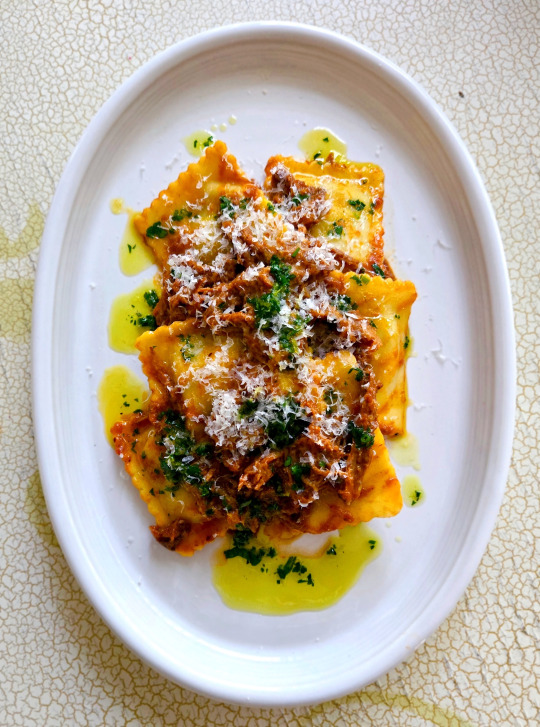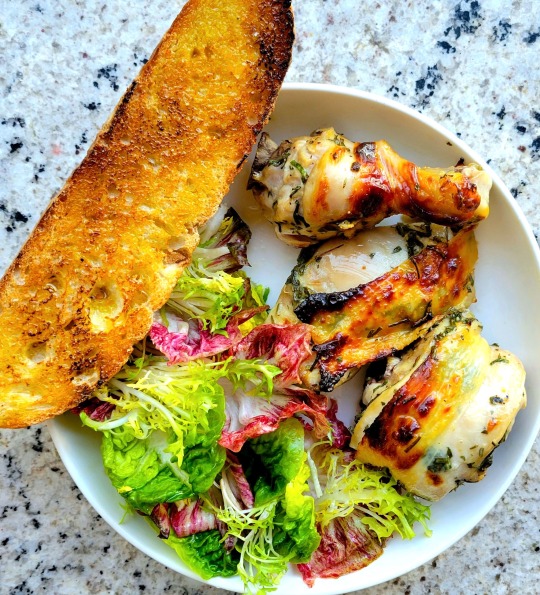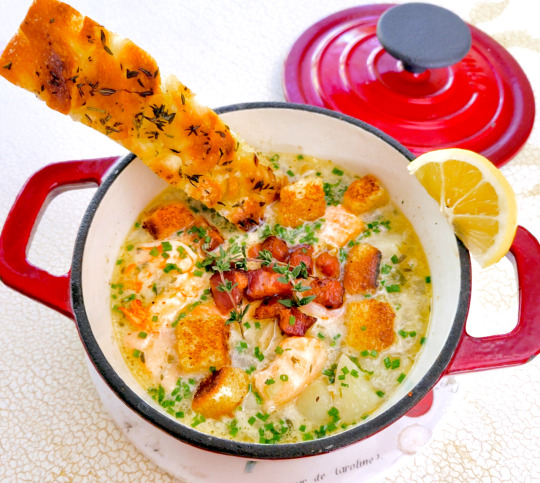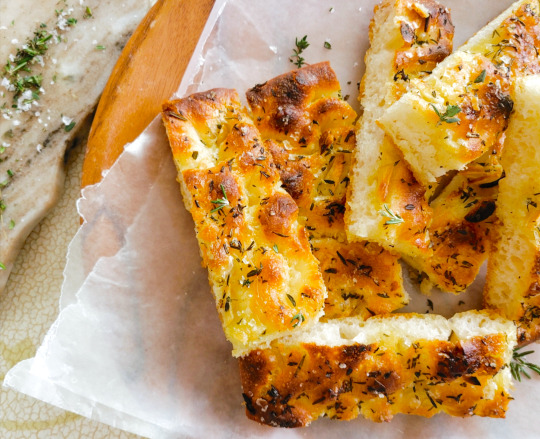Text
farmer's market | strawberry & honey castella cake tart

When the proper season finally arrives, and the ambrosia of the world begin blooming and blanketing the farmer's market with their perfumes so indescribably violent, you can't help but go on a shopping bender to purchase a little bit of everything your eyes see and your nose smells. With the balmy mediterranean climate of southern california, many fruits and produce are gratefully available near year-round for us to gorge on. And strawberries... they are one of my absolute favorite foods, and I want nothing more during summer than to eat a whole bowlful of resiny rose-scented strawberries for breakfast, lunch, and dinner.
This year, strawberries were available already, and having missed them so much, I couldn't resist picking them up. And because I want their flavor to shine without apology, I like to make just a simple, rustic tart based on that timeless favorite, the strawberries & cream cake—though I think this is one of the best tarts I've ever eaten because of how much the complexity of the strawberries is allowed to shine here. After all, when preparing foods with high quality produce from the farmer's market, less is more; you're ordered to be idle, as Nigella would say. And to do my part in adhering to that excuse (and not just because the last thing I'd like to do in the heat of summer is to turn on the oven to bake another cake), I sometimes use a good ready-made honey castella cake that I can purchase from the japanese store, so it makes quick work of this assembly. But a chiffon cake or even a joconde would be wonderful in place of the castella cake. Because I use a rich, local cream with minimum 40% butterfat, I found that adding a layer of crème diplomat didn't enhance the tart at all as the creme chantilly alone was sufficiently full-bodied.
Oh, I pressed some freeze-dried strawberries to my crust to try a new look, but they do kind of look disgustingly like ulcers so... make of that choice what you will.
I crowned my tart with a few daisies from my garden, and filled the tart with towering rumples of chiffon-like frills of cream to give the tart an almost Marie Antoinette-like look of vintage grandeur. That also means confectioner's sugar in lieu of a nappage on the strawberries and tart shell. In a perfect world, I think I would have liked to use strawberry blossoms (or white poppies, or peonies, or even roman chamomiles), but I only had one that was blooming at the moment. And I ran out of gaviotas for the first tart, so I had to use some regular white-fleshed strawberries for the second tart in the picture above. A little downhearted by these little things... but there are too many things to be already thankful for in this world that I think they can be excused. And there is something about these sun-filled daisies that are so inviting and innocent in their simplicity anyway; no makeup.
farmer's market | strawberry & honey castella tart
gaviota or other strawberry varieties with a violent sweetness good ready-made honey castella (or chiffon) pâte sucrée (see below) mara des bois confiture, or of any complex strawberry variety—otherwise, use strawberry preserves with a touch of seedless raspberry preserves tahitian vanilla soak (e.g., simple syrup with tahitian vanilla paste or a milk mixture with vanilla for a tres leches construction) crème chantilly (see below) valrhona caramelia crunchy pearls (optional, for garnish) edible flowers (optional, for garnish) spread the confiture on top of the cooled crust. add slices of castella, soak the cake, then add a thin layer of cream, making sure to fill in any gaps between the crust and the castella. decorate with cream, gaviota, and garnishes as desired.
pâte sucrée - makes well enough for two 8 2/3in / 22 cm tart bases (or 8+ smaller tartlets)
2 sticks (225g) butter, soft but cool 120g confectioners sugar 1 large egg 1 large egg yolk 425g / 3 cups cake flour pinch of salt if the butter is not a cultured butter
cream butter and sugar until fluffy. add egg, beaten, and flour, and mix until fully homogeneous. refrigerate at least 2-3 hrs, if not overnight. once molded, freeze again for 15-30 min until solid, then bake. can freeze half the batch.
375F, blind bake 20 min or until parchment comes off cleanly. do not rush—it will crumble otherwise. leave in oven for 10 ish more min post-blind baking, and do not overbake—color should just start to turn light golden brown at very top of the crust and at center of the base. you may add almond flour to the dough for a fraisier profile.
crème chantilly
24 fl oz / 710ml good cream with 40% butterfat (6g of fat / 1 tbsp or 15ml) 6 tbsp of granulated sugar 1½ gelatin leaves* smallest pinch of salt smallest drop of tahitian or mexican vanilla paste for triple fold, a little more for double folds (let the quality and taste of the cream shine) bloom gelatin leaves in cool water. whip cream until frothy. add salt, then sugar by the spoonful. add vanilla. keep whipping until nearly firm peaks. melt gelatin just until melted, 5 seconds or so; be careful as gelatin becomes stringy if heated too much. carefully stream gelatin to cream while whipping constantly; there is no need to temper by diluting the gelatin with cream beforehand (which I find encourages the gelatin to seize). chill until ready to apply. *while I use 200 bloom power, gelatin sheets of different bloom powers are produced with different weights to compensate for the various powers. Meaning, you can use 1½ leaves of any bloom power.
5 notes
·
View notes
Text
lazy day | short rib & brisket ragu and gremolata, on ready-made mushroom raviolli

There are just times—certainly during many workdays—when we can't fathom the idea of cooking because of the schedules that life demands from you. Or on those sundays that are a bit too rainy for you to want to get out of bed and do anything but lazy around. It is on these nights that we wish for nothing more than to open a few jars, mindlessly throw the contents into a pot, but still have something warm and comforting to eat. And thankfully, some dishes, though not most, are gracious enough to be amenable to shortcuts with the help of the supermarket—this ragu happens to be one of them.
It is uncompromisingly delicious, very hearty, and deeply savory due to the short rib and brisket, and the long cooking mellows the subtler notes of the aromatics enough, that using a jar of good quality tomato sauce like Rao's well fulfills the role of homemade marinara. And anyway, you want the flavors of the brisket and short rib shine; if the aromatics are too assertive, such cuts a waste to use. The pestata (which here is really just blended soffritto) dissolves into the ragu as it cooks, and at the end of the braising when most of the liquid has evaporated, adds a subtle creaminess to the sauce, along with that lovely signature taste of bolognese hinted from behind the robust beefy taste that takes forefront stage. And I only add cheese when finishing the dish, instead of adding it into the sauce pre-braise—I find that it muddies the flavor and depth of the ragu.
I love this with a good mushroom ravioli that I purchase at a local italian deli, filled with all kinds of mushrooms and other good things like madeira and garlic and herbs. If I'm using a filled pasta that already includes truffle, then I omit it in the ragu, but if not, I like to add a little bit to the ragu itself at the end so that it can harmonize softly with the mushroom filling in the pasta. It is still perfectly wonderful without it, however, so do not feel obligated to add it. Searing the meat is the most time-consuming part of the preparation that you will have to devote in the morning, but the pot should be in the oven and braising within 30 minutes of entering the kitchen. Let the ragu simmer while you're away at work or running errands on a lazy sunday, so once you come back home after the long day, all that's required of you is to boil some good quality, ready-made pasta for a few minutes, toss in the sauce, turn on the television, and relieve the day's worries with a warm, cozy bowl. Do not skim the fat; it is this fat that stains the pasta a sunset mahogany and coats the ragu with a luxurious, velvety mouthfeel.
lazy day | short rib & brisket ragu with gremolata for 6-8 servings 1 lb (453g) brisket 2 lb (907g) bone-in short rib 16.9 oz (479g, about a pint) beef bone broth 24 oz (680g) of a clean-tasting, bright tomato sauce (e.g. standard jar of Rao's marinara or arrabiata) 10 oz (283g) prepared soffritto / mirepoix (1:1:1 onion, celery, carrot) 4 cloves of garlic a little bit of fresh woody herbs, e.g. a small sprig of rosemary, thyme, & marjoram, just to impart slight warmth sear meat deeply. blend the soffritto with the garlic, and cook at high heat in the leftover tallow, adding olive oil if additional fat is needed, until the water evaporates. lower the heat and sweat gently for 10 minutes with the herbs added whole. add bone broth, herbs, tomato sauce, and nestle in the meat, making sure that the bones of the short ribs are submerged. 270F (130C), ~7 hours, with lid slightly ajar—though adjust the temperature according to how long you will be away, as you will need to stir the sauce about the last two hours of cooking to prevent scorching. fish the herbs out and shred the meat with a fork. drizzle with a gremolata:
gremolata californian olive oil 1 tbsp parsley or basil 1 tbsp chives zest of a small lemon 8 rosemary needles, equivalent of thyme, & 4 leaves of marjoram salt nutrition for ragu only (rough approx.): ~2800 kcal, 219g protein (350 - 467 kcal / 27 - 36.5g per serving)
1 note
·
View note
Text
buttermilk & herb chicken with garlic crostini and simple salad 🅟

I love roasted chicken—something so incredible and fresh about its burnished blistered skin, crackling to unveil the juicy bouncy flesh in the heat of 450F. The drippings that render from chicken naturally, even when just showered with salt and freshly crushed black pepper, already have an indescribably complex and full profile.
However, if you do wish to infuse aromatics, it is paramount that they are stuffed under the very skin itself, which not only is sufficient to halfway imitiate the incredible juiciness of a brined bird, but perhaps more importantly also gives heady infusion of the marinade right into the drippings; these drippings have a taste just so far removed from your idea of flavored chicken fat that it was incredibly hard not to scarf down the whole loaf of crusty bread with it, dunking and munching (my favorite bread to have with is one with very high hydration, nearing a pan cristal, with a shatteringly thin crust and a porous supple inside). Merely stuffing the cavity offers the most feeble suggestion of aromatics that it's as if the drippings were muddied, rather than flavoured.
The other option is, of course, a marinade or brine, as I'm doing here if you can afford yourself some weekend leisure—and perhaps its potency is none better showcased than with a buttermilk brine. Alone the chicken takes on an unimaginative milky note, but the herbs introduced turn the dish into indescribable magic. A heady amount of chives with the buttermilk gives the chicken a bright flavor somewhere between a green goddess and a buttermilk ranch/sour cream & onion at first bite, but the woody herbs finish the palate with a warm complexity. The buttermilk also gives a wonderful contrast between parts of the skin that become charred and other parts that have a wonderfully bouncy mouthfeel to them—a sometimes welcome break from the incredibly thin, crisp, and crackly skin of a normal roasted chicken.
Serve a side salad with this, and you have the most perfect lunch under early summery skies.
buttermilk & herb chicken with garlic crostini and simple salad
for the roasted chicken chicken 1 liter (33.8 fl oz) buttermilk
fresh herbs: 2 bunches (2 cups) of roughly chopped chives 2 tbsp minced parsley 2 tbsp minced basil 1 tbsp thyme 1 tbsp marjoram 1 tbsp minced sage 1 turkish bay leaf salt a touch of honey (just the smallest bit to assuage the tang of the buttermilk and to blister the skin, but it should not assert its sweetness in the slightest) cultured butter (a tbsp or so) brine chicken with buttermilk, herbs, salt, and honey overnight. pat incredibly dry (you do not want curdled buttermilk in your pan drippings), stuffing some of the herbs into the skin. scatter knobs of the cultured butter over the chicken before roasting—this part is essential for the most unbelievable flavor pairing with the marinade that returns pure chicken jus elixir. 450F for 25 minutes for already partitioned chicken pieces, and broil until the skin is slightly charred (the buttermilk discourages this). - for the crostini crusty bread garlic clove californian olive oil maldon salt in a dry pan toast a crusty piece of bread. while warm (very important), rub a cut garlic clove onto it. drizzle californian olive oil and maldon salt. - for the salad greens (I chose little gem, chicory, and frisee from the farmer's market) californian olive oil champagne (or white balsamic) vinegar salt tear greens gently—that way, the torn edge of the leaves will preserve the same texture as the rest of the leaf. with your hands, gently toss the greens with the olive oil, vinegar, and salt.
🅟 indicates a high-protein meal (that is, at least 10g of protein for every 100cal)
0 notes
Text
soup, sandwich, & stuff | clasic seafood potato chowder & herb focaccia


I'm not much of a person for soup as a standalone meal, but it goes without saying that the interplay between soup and sandwich turns it to nothing short of divine—in both the contrasts in texture and taste. Well, a focaccia isn't a sandwich, but with its oily rich chewiness paired with the creamy, briny heartiness of the chowder, you won't find yourself missing it.
I think I first had this sort of pairing back when souplantation was still in business, and it quickly became my go-to when I went there with my family as a kid. Now I generally prefer my chowders to be on the lighter side with just enough roux and cream to add a little body to the soup, choosing to highlighting the briny herbiness of the soup instead—though, I do use a looser hand on the herbs, cream, and bacon when it's wintertime to make the soup a bit more stick-to-the-ribs (it also gives the soup a rather cozy cottage-like look, I feel).
It's very delicious and hearty, and a perfect holiday lunch to warm yourself up, so please do give it a try.
classic seafood potato chowder for 3-4 servings
2 tbsp (30g) cultured butter (double for thicker) 1 1/2 (12g) tbsp flour (double for thicker)
5 sprigs of thyme, whole 1/2 of a celery stalk, minced finely 1 shallot, minced finely 5 garlic cloves, minced finely 1 fresh turkish bay leaf
1/2 (230g) pound of shrimp 3/4 lb (340g) of salmon or red snapper, cubed into bite-size pieces 3/4 lb (340g) baby yellow potatoes, cubed into bite-size pieces
1/3 pt (160ml) heavy cream 16 fl oz (240 ml) clam stock
1/4 lb (100g) slab smoked bacon, cut into small cubes
1 medium-thick slice of brioche, cut into small cubes like the bacon and well-toasted in butter (though if serving with focaccia, you don't need it)
chives, minced finely coarsely cracked black pepper and a squeeze of lemon
saute aromatics with butter until tender. add flour and make a veloute with the clam stock. add thyme, bay, and potatoes, and simmer until the potatoes are just tender, around 10-15 minutes. add salmon and cream, and poach the fish very gently until just shy of cooked, 3-5 minutes. add shrimp and poach for a minute or 2 more until cooked. finish the soup with cooked cubed bacon, crunchy brioche croutons, a smattering of chives, a squeeze of lemon, and very coarsely crushed black pepper.
nutrition (rough approx.): ~1630 kcal, 118g protein (408 - 543 kcal / 29.5 - 39g per serving)
-
herb focaccia for 10 × 15 pan
500g flour 80% hydration (400ml water) 1.8% salinity (9g salt) .25 oz fresh yeast / 3g dry yeast
2 tbsp + generous amount of extra virgin olive oil generous handful of equal parts fresh rosemary and thyme, finely minced
maldon salt garlic slivers (optional)
proof yeast in 100-110F water first if needed. then, mix flour and salt into the yeast mixture and mix until a dough just begins to form. rest for 20 min.
perform 3 sets of stretches + folds (each consisting of a three-fold in one direction as you would when laminating croissant dough, then another three-fold in the perpendicular direction), each spaced 20 minutes apart. after the last set, lather the dough with 2 tbsp of olive oil and let it rest for another 20 min.
place dough onto a 10 × 15 sheet pan (or 9 × 13 for a thicker focaccia) generously lathered with olive oil and stretch it to fill. rest the dough overnight in the refrigerator, and proof for 2 hours before ready to bake.
generously drizzle olive oil over the top and dimple the dough, forming oily pockets. scatter with herbs generously and maldon salt. add slivers of fresh garlic inside the crevices of the dimples if desired, and add a bit more oil for good measure.
500F, with another tray preheating inside. start checking at around 17 minutes for a deep golden brown with a few blisters.
It's also fantastic to make a panini with; I especially love it with a basil aioli and thinly shaved porchetta rovagnati. And if I'm feeling particularly american 🎆🦅🇺🇸🎇🌭, I make a version with jalapeno and cheddar.
happy holidays from los angeles! 🎄

2 notes
·
View notes